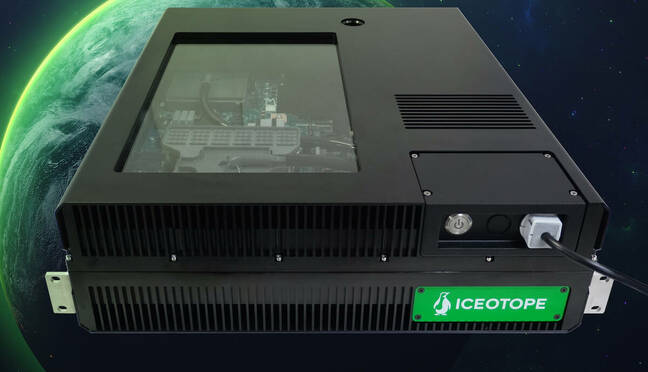Iceotope Cooks Plan For Liquid-cooled Servers At The Edge
The edge probably isn't the first place you'd expect to see liquid and immersion cooling tech, but Iceotope aims to put them there anyway.
Of course, the edge itself is still a bit of a nebulous category. At one extreme are the full-fat server chassis deployed in temperature-controlled branch offices. At the other, you'll find non-standard industrial systems with passive heat sinks, weather sealing and hardened silicon designed to cope with extreme temperature swings.
The latter environments are particularly tricky because warehouses and factory floors don't always have the necessary air handling and environmental controls necessary to prevent dust, humidity, or high ambient temperatures from mucking up systems.
The KUL RAN system, developed by in collaboration with HPE and Intel, appears to fall somewhere in the middle of these two extremes. The system features a 19-inch short-depth rack mount form factor based around HPE's ProLiant DL110 platform Intel's 4th-gen Xeon Scalable processor family. From that standpoint, it's a pretty run-of-the-mill edge server but sets it apart is how Iceotope is going about cooling the system.
Typically, liquid-cooled systems require a fair bit of supporting infrastructure, including pumps, coolant distribution units, rack manifolds to distribute the coolant, and heat exchangers. However, Iceotope claims that with its KUL RAN platform, all of this functionality is self-contained within the system.
Rather than fans and heat pipes or big, heavy passive heat sinks, the KUL RAN system is sealed off from the outside atmosphere and employs Iceotope's rack-mount immersion cooling tech to keep temps in check. We took a look at this in person at Supercomputing 22.
It works by submerging the motherboard in a few millimeters of non-conductive coolant, which is then pumped to hot spots, like the CPU, GPU, memory, and other components. Heat from the system is captured and passed to a heat exchanger at the back of the system.
- Vultr Cloud Alliance rises to take on cloud Goliaths
- Fresh details on the flash that sits inside Mars Perseverance Rover
- Money starts to flow as liquid cooling gets hot in datacenters
- Intel pours Raptor Lake chips into latest NUC Mini PC line
Iceotope's KUL RAN systems are targeted at telco edge with 5G radio access network (RAN) applications in mind for the platform. This would also explain the use of Intel's 4th-gen Xeons. Intel launched 5G and telco-specific SKUs of its chips earlier this year, while we're still waiting for AMD's edge-focused Epyc Siena parts to hit the market later this year.
Intel has also been investing heavily in next-gen cooling technologies, particularly around improving the efficiency of immersion-cooled systems.
Last week, the company revealed it'd been awarded a $1.7 million contract under the Department of Energy's COOLERCHIPS initiative to develop novel heat sink designs for phase change immersion-cooled systems capable of taming 2KW components.
We'll note the 4th-gen Xeons found in Iceotope's KUL RAN platform aren't nearly so demanding with peak TDPs maxing out at around 350W. ®
From Chip War To Cloud War: The Next Frontier In Global Tech Competition
The global chip war, characterized by intense competition among nations and corporations for supremacy in semiconductor ... Read more
The High Stakes Of Tech Regulation: Security Risks And Market Dynamics
The influence of tech giants in the global economy continues to grow, raising crucial questions about how to balance sec... Read more
The Tyranny Of Instagram Interiors: Why It's Time To Break Free From Algorithm-Driven Aesthetics
Instagram has become a dominant force in shaping interior design trends, offering a seemingly endless stream of inspirat... Read more
The Data Crunch In AI: Strategies For Sustainability
Exploring solutions to the imminent exhaustion of internet data for AI training.As the artificial intelligence (AI) indu... Read more
Google Abandons Four-Year Effort To Remove Cookies From Chrome Browser
After four years of dedicated effort, Google has decided to abandon its plan to remove third-party cookies from its Chro... Read more
LinkedIn Embraces AI And Gamification To Drive User Engagement And Revenue
In an effort to tackle slowing revenue growth and enhance user engagement, LinkedIn is turning to artificial intelligenc... Read more


